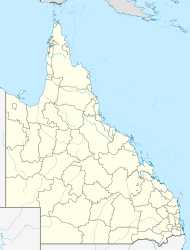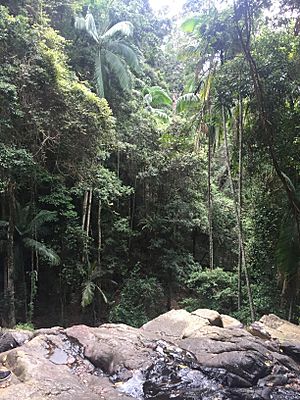D'Aguilar National Park facts for kids
Quick facts for kids D'Aguilar National ParkQueensland |
|
|---|---|
|
IUCN Category II (National Park)
|
|

Westridge Outlook, D'Aguilar National Park
|
|
| Established | 1938 |
| Area | 20.50 km2 (7.9 sq mi) |
| Managing authorities | Queensland Parks and Wildlife Service |
| Website | D'Aguilar National Park |
| See also | Protected areas of Queensland |
D'Aguilar National Park is a large national park in Queensland, Australia. It covers the D'Aguilar Range and is found northwest of the city of Brisbane. You can drive through the park on the scenic Mount Nebo Road and Mount Glorious Road.
The park has many different landscapes. You will find open eucalyptus woodlands and cool, sheltered pockets of sub-tropical rainforest. There are also amazing views of Moreton Bay and the Glass House Mountains. The Walkabout Creek Visitor Centre is right at the edge of the park. It's a great place to start your visit.
If you like camping, there are two main camping areas you can drive to in the Mount Mee section. There are also eight remote bush camping spots. You can only reach these by walking. Popular spots for great views include Jolly's Lookout, Westridge Outlook, Camp Mountain Lookout, and Wivenhoe Lookout, which overlooks Lake Wivenhoe. The small towns of Mount Nebo and Mount Glorious are on Mount Nebo Road. They are popular stops for people driving through the park. The southern part of the park used to be called Brisbane Forest Park. The northern part is near Mount Mee.
Contents
What Plants Grow in D'Aguilar National Park?
The park is home to many types of plants.
Trees in the Foothills
In the drier, lower parts of the park, you will see many woodlands. These areas have dry eucalyptus forests. Some of the main trees include Spotted Gum and Narrow-leaved Ironbark. You might also find small areas of heathland. These are open areas with low shrubs. Some ridges are covered mostly by grass trees, which look like spiky plants. In the valleys, along some creeks, you can find small areas of lowland rainforest.
Forests at Higher Altitudes
As you go higher up the mountains, the forests change. They become thicker and more complex. This is because there is more rain and deeper soil. These middle-height forests have trees like Grey Gum, Pink Bloodwood, and Brush Box. You might also see some rainforest trees mixed in. The ground beneath the trees is often thick with ferns, vines, and shrubs.
Rainforests on the Highest Peaks
The highest parts of the D'Aguilar Range get the most rain. Here, you will find moist sub-tropical rainforests. The rainfall here is two-thirds more than in the lower areas. This is especially true north of Mount Glorious, where the soil is rich. You can see huge strangler figs growing very tall. They often grow around other trees.
What Animals Live in D'Aguilar National Park?
D'Aguilar National Park is a great place for wildlife. Many different animals call it home.
Birds of the Park
More than 240 types of birds have been seen in the park. Some of these include the noisy pitta and the southern logrunner. You might also spot the paradise riflebird or the regent bowerbird. Other common birds are the satin bowerbird and the Australian brushturkey. You can often hear the laughing kookaburra. Larger birds like the white-bellied sea eagle also live here.
Mammals of the Park
The park has 66 different kinds of mammals. You might see an echidna or even a platypus in the water. There are also red-necked pademelons, which are small kangaroos. Different types of possums live here, like the short-eared possum and the common ringtail possum. You might also spot bandicoots, potoroos, and many kinds of bats. Sometimes, you can see koalas and kangaroos.
Reptiles and Frogs
The park has many reptiles. One common reptile is the lace monitor, which is a large lizard. Another is the land mullet, a big, shiny black skink. There are 26 types of frogs in the park. This includes the great barred frog. However, the most common amphibian you might see is the cane toad. It is an introduced animal that can be a pest.
Images for kids
See also
 In Spanish: Parque nacional D'Aguilar para niños
In Spanish: Parque nacional D'Aguilar para niños





